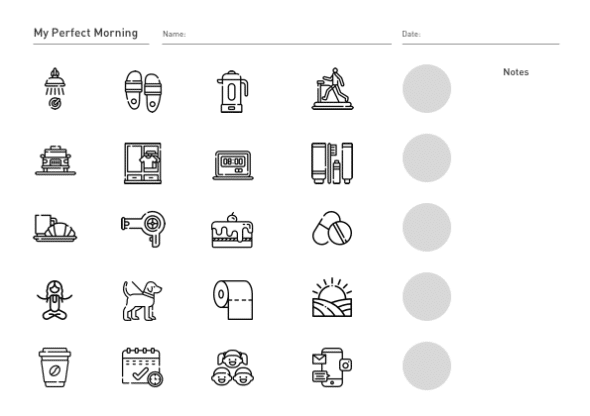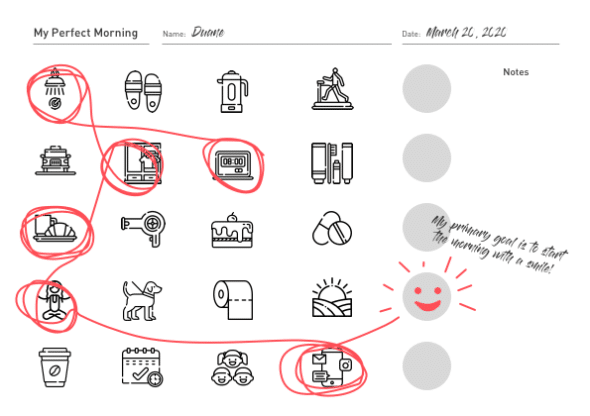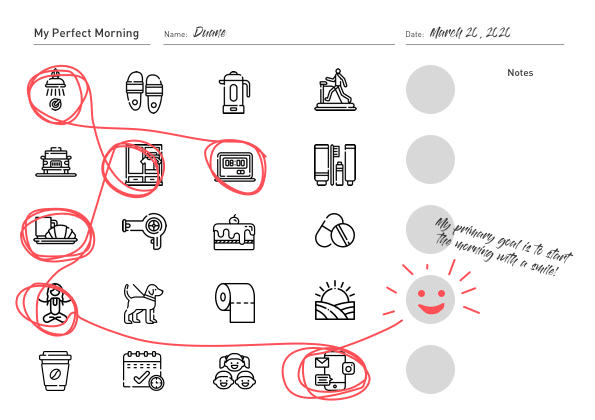Do you want the customer’s perspective on a workflow or process? Are you trying to discover which touchpoints are the most meaningful to your customers? The Perfect Morning is the activity for you.

This is part of our series on Design Thinking Methods and Activities. You’ll find a full list of posts at the end of the page.
The goal of The Perfect Morning is to understand how a person completes a process or workflow. It can be used with current, future, or idealized scenarios.
| Primary Goal | To understand a person’s perspective of a current or future experience |
| When to Use | As a precursor to a more detailed user journey activity |
| Time Required | 20-40 minutes |
| Number of Participants | 1-10+ |
| Who Should Participate? | End customers or users of your solution |
| Supplies | Sharpies and an activity worksheet |
1. Choose a Process/Workflow
To do this activity, you must have a workflow in mind. For example:
- Finding the perfect morning routine
- Hailing a rideshare vehicle
- Planning and leaving for a trip abroad
- Cooking your favorite meal
- Returning a package
- Setting up and participating in a conference call
- Paying your taxes
- Adopting a pet
Today, I’ll be using finding the perfect morning routine.
2. Create Your Worksheet
You’ll need an activity worksheet — a set of graphics that depict actions, items, or emotions. The goal is to create a variety of options someone can choose from to describe their current process or a “perfect” scenario.
For example, if I were trying to understand a person’s vision of their perfect morning, I’d use graphics of common morning activities:

The graphics should be simple and vague so each participant can apply their own meaning. Leave at least five blanks (like the gray circles above) where participants can add their own drawings. And be sure to leave a little open space for notes or other doodles.
3. Run the Activity!
Give each participant a worksheet and a marker, and set a timer for five minutes. Tell them to circle, in order, the activities they would perform to create a perfect morning. Then ask them to describe the emotion they’d like to feel at the end of that experience. Encourage them to add new drawings and leave notes as they go. Participants should be silent to allow for unbiased thinking and deeper self-reflection.
A participant’s worksheet might look something like this:

Once the time is over, have each participant walk the group through their version of a perfect morning. Encourage them to speak in detail about why they’ve chosen each step.
4. Synthesize Your Findings
Once you’ve completed the activity and gathered as much feedback as possible from participants, it’s time to identify common patterns and themes. Look across all participant worksheets and remember, in particular, the areas or steps they were extremely passionate or excited about. Similarly, note tasks or steps that frustrated or annoyed them.
An activity like Affinity Mapping or Rose, Bud, Thorn might be useful to synthesize this information.
Good luck and have fun finding your perfect morning!
This activity was created by Stanford d.school.
Atomic’s Design Thinking Toolkit
- What Is Design Thinking?
- Your Design Thinking Supply List
- Activity 1 – The Love/Breakup Letter
- Activity 2 – Story Mapping
- Activity 3 – P.O.E.M.S.
- Activity 4 – Start Your Day
- Activity 5 – Remember the Future
- Activity 6 – Card Sorting
- Activity 7 – Competitors/Complementors Map
- Activity 8 – Difficulty & Importance Matrix
- Activity 9 – Rose, Bud, Thorn
- Activity 10 – Affinity Mapping
- Activity 11 – Speed Boat
- Activity 12 – Visualize The Vote
- Activity 13 – Hopes & Fears
- Activity 14 – I Like, I Wish, What If
- Activity 15 – How to Make Toast
- Activity 16 – How Might We…?
- Activity 17 – Alter Egos
- Activity 18 – What’s On Your Radar?
- Activity 19 – The Perfect Morning
- Activity 20 – 2×3
- Activity 21 – How Can I Help…?
- Activity 22 – Cover Story
- Activity 23 – Crazy 8s
- Activity 24 – Abstraction Ladder
- Activity 25 – Empathy Map
- Activity 26 – Worse Possible Idea
- Activity 27 – Pre-Project Survey
- Activity 28 – The Powers of Ten
- Activity 29 – SCAMPER
- Activity 30 – Design Studio
- Activity 31 – Forced Connections

